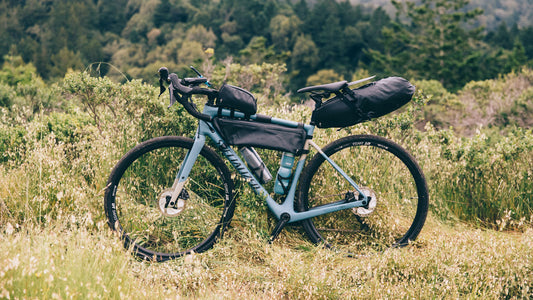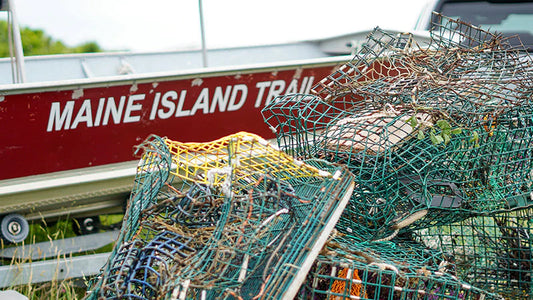We pulled into the parking lot for Black Mountain of Maine (BMOM) early on a Saturday morning in October. It was cold and wet—you know, good ol' New England weather. In typical fashion, Tyler Ray, Granite Backcountry Alliance Founder and aptly titled “Granite Chief,” had more energy than any human should at this hour, and was busy getting the “quarry dogs” primed for the day ahead. It was a big crowd on this day, the largest of the 2020 Glade Tour. Loppers, saws and hard hats were divvied up, and, before long, we were hiking up one of BMOM’s ski trails and into the clouds... literally.


In coordination with BMOM and Mahoosuc Land Trust (the local land conservation group), Granite Backcountry Alliance (GBA) was granted access to build and expand upon a glade network located in the heart of Western Maine’s ski country. Pretty exciting stuff! While GBA's efforts have been focused in New Hampshire (hence the "Granite" in GBA), they've recently been able to expand their efforts into Western Maine. We need to mention—much credit is due to the Angry Beavers of Maine, the local volunteer group that has been building and maintaining glades in this region for years. The coordination between a ski resort and a group of trail builders is certainly unique in our neck of the woods. The opportunity to be a part of the Black & White Glade project was something that we didn’t want to miss.
 After climbing to the top of BMOM, we departed from the resort ski trail and headed onto a designated uphill route that accesses much of the terrain on the mountain’s backside. Through the thick fog, you could begin to hear the distant sound of chainsaws in the forest. The “saw dogs,” the chainsaw operators certified by the National Forest Service, get much of the heavy lifting done. Strategically taking down trees along the designated glade lines, the work they do is more of an art, leaving the right trees behind to retain the natural beauty of the landscape.
After climbing to the top of BMOM, we departed from the resort ski trail and headed onto a designated uphill route that accesses much of the terrain on the mountain’s backside. Through the thick fog, you could begin to hear the distant sound of chainsaws in the forest. The “saw dogs,” the chainsaw operators certified by the National Forest Service, get much of the heavy lifting done. Strategically taking down trees along the designated glade lines, the work they do is more of an art, leaving the right trees behind to retain the natural beauty of the landscape.

 The approach to building these backcountry glades is nothing short of impressive. Everyone has a job to do, which is clearly defined by each group’s “pack leader.” All vegetation essentially stays in place, rather than being piled on the sides of the trail. This helps to control erosion, and the decomposition of these materials helps to benefit the long-term health of the forest. After the saw dogs do their part, the “swampers” hand cut the fallen trees into more manageable pieces and move brush out of the saw dogs’ way. Next, the quarry dogs come rolling through with loppers and handsaws, removing branches and smaller trees (less than 3” in diameter) that may have been missed on the first pass. They also take time to further break down what lies in the trail, ensuring the trails can be skied and ridden safely once the snow flies. If you see an opportunity to build a nice booter out of an old stump or rock, well that’s encouraged, too.
The approach to building these backcountry glades is nothing short of impressive. Everyone has a job to do, which is clearly defined by each group’s “pack leader.” All vegetation essentially stays in place, rather than being piled on the sides of the trail. This helps to control erosion, and the decomposition of these materials helps to benefit the long-term health of the forest. After the saw dogs do their part, the “swampers” hand cut the fallen trees into more manageable pieces and move brush out of the saw dogs’ way. Next, the quarry dogs come rolling through with loppers and handsaws, removing branches and smaller trees (less than 3” in diameter) that may have been missed on the first pass. They also take time to further break down what lies in the trail, ensuring the trails can be skied and ridden safely once the snow flies. If you see an opportunity to build a nice booter out of an old stump or rock, well that’s encouraged, too.
Each crew is assigned a zone, in order to spread out the volunteers and help cover the most ground. It’s incredible what 100 volunteers can accomplish in a day’s work. Knowing that you’ll be able to return and ski a line that you have sweat equity in only adds to the motivation. Not since the 1930’s, when the Civilian Conservations Corps cut some the nation’s first and most historic backcountry ski trails, has such an effort taken place in New Hampshire or Maine.
Our group, dubbed “team hot lunch,” consisted of a number of Good To-Go employees, friends and family. We got the name because, when we stop for lunch, you know we have to represent. Good To-Go dehydrated backpacking meals for everyone!


This was our second time joining GBA for a day of glading. Something that stood out this time around was the number of kids in attendance, some of whom weren’t even 10 years old. These kids are the future of the sport—the “pipeline,” as Tyler Ray put it. Seeing young ones spend a full day slogging up and down a mountainside with loppers and handsaws—in cold, rainy conditions—is super inspiring. The handing down of values was on display, and, as these kids grow up knowing access to these beautiful places, it’s more than likely they’ll have an interest in preserving them.


At the end of the day, after the glade chief and pack leaders deemed the work was done, we headed out of the forest and back onto the resort trails, with clear skies, rolling hills and beautiful fall foliage in view. Once we arrived at the base of BMOM, all were rewarded with a special beer release from Baxter Brewing and a meal from Good To-Go. While we can’t wait to get back this winter to try out this new zone, we also look forward to next summer and fall, when we can spend another day with friends glading in the mountains.

Whether you’re new to backcountry skiing and splitboarding or have been enjoying the classic lines in the Presidentials for years, there’s never been a better time to ditch the lift line and enjoy the benefits of human-powered adventure. Head over to granitebackcountryalliance.org to find maps and info on the Black & White Glade and all of their recent projects. While you’re there, please consider becoming a member. Those who do will enjoy perks, including discounts on Good To-Go!
Story and photos by Justin Hagen of Good To-Go





